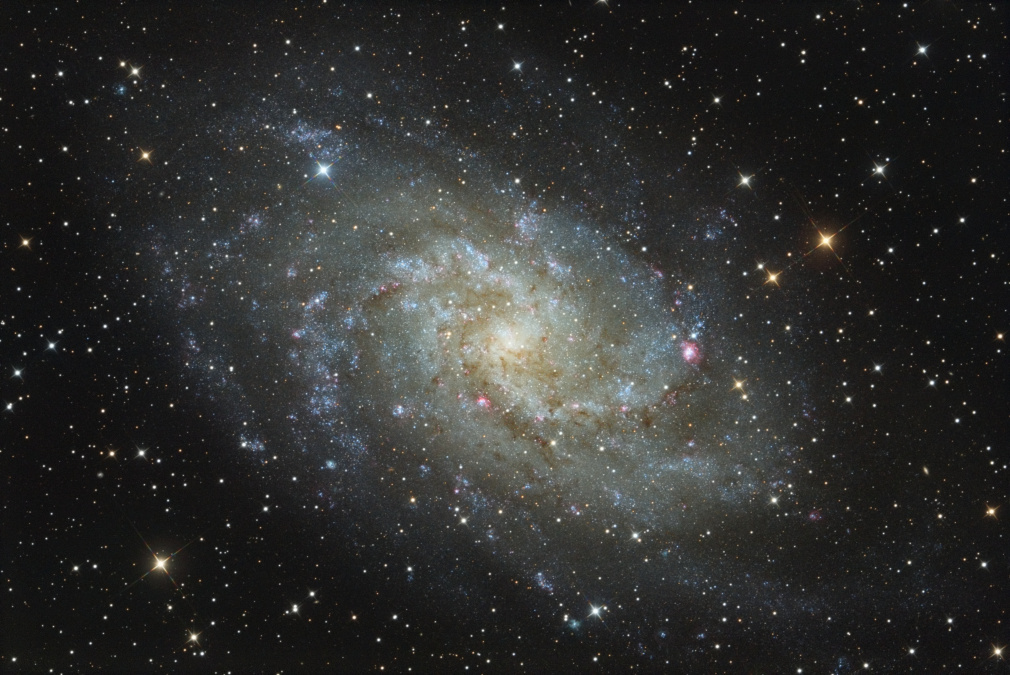The third largest galaxy in the Local Group is Messier 33, the Triangulum Galaxy which is barely visible to the naked eye, even in the darkest skies. It is also the farthest permanent object that can be seen without a telescope.
The first written note about this galaxy was made more than a century before Messier. Giovanni Battista Hodierna Italian astronomer wrote about an object located in the Triangle and whose brightness was similar to the brightness of M33. This note was published in his work called De systemate orbis cometici; deque admirandis coeli caracteribus (About the system of cometary orbits and the wonderful objects in the sky). Messier - not knowing about this work - has re-discovered the galaxy in 1764 and added it to his catalogue as the 33rd object. Twenty years later William Herschel added four of the galaxy's HII regions to his catalogue as separate objects (NGC 604, NGC 588, NGC 592, NGC 595). In 1850 Triangulum Galaxy was described as a spiral nebula by Lord Rosse. In the 1920's Edwin Hubble successfully identified classic Cepheid variables in it, which he could use to determine the distance of M33. The results he got did support his point of view in the debate of the era about wether spiral nebulae are part of the Milky Way, or not. As we know already, Hubble was right, these objects are much too far to be part of our galaxy.
Its distance is 2.5-3 million light-years approximately and its diameter is 60 thousand light-years, which is about half of the diameter of the Milky Way. It consists of 40 billion stars only, dwarfed by the 400 billion stars of our Galaxy, and the 1000 billion stars in the Andromeda Galaxy. A giant black hole is located in the core of M33 with an estimated mass of 3000 solar masses, and the most powerful ULX known in the Local Group. ULXs or ultra luminous X-ray sources are objects that emit more X-ray radiation than any known stellar phenomenon, but not as much as active galactic nuclei do. We don't exactly know what these objects are, and how do they work, but according to recent theories they may be X-ray radiation emitted by accretion discs around intermediate-mass black holes.
M33 also contains the biggest known black hole that was formed by the gravitational collapse of a single star. The object named M33 X-7 was found on images made by Chandra X-ray telescope. It is almost 16 times more massive than our Sun. The black hole is orbiting a star and fortunately we are exactly in the plane of the orbit, therefore the black hole transits in front of the star in every 3.5 days.
In 2004 a dim tidal tail formed of stars and hydrogen was found between the Triangulum Galaxy and the Andromeda Galaxy, providing evidence that these two galaxies has been in gravitational interaction in the past. Actually there is also an estimation that it happened about 2-8 billion years ago. Proper motion of M33 was calculated using data acquired by by VLBA in 2005. It turned out M33 is moving towards Andromeda Galaxy. Based on the former interaction and the direction of movement it is probably that M33 is a satellite galaxy of Andromeda.
Destiny of M33 is not yet known for sure, as many of the measurements are not accurate enough. What we know for sure is that Andromeda Galaxy and Milky Way will collide in 4 billion years from now. Triangulum Galaxy will either collide with Andromeda Galaxy, get torn apart by and merge with Andromeda before the two large galaxies collide, or it will merge with Milky Way before the two giants collide. The most probable outcome is that M33 will orbit the new giant galaxy formed by the merger of Andromeda and Milky Way for a while, before the new galaxy tears it apart.
